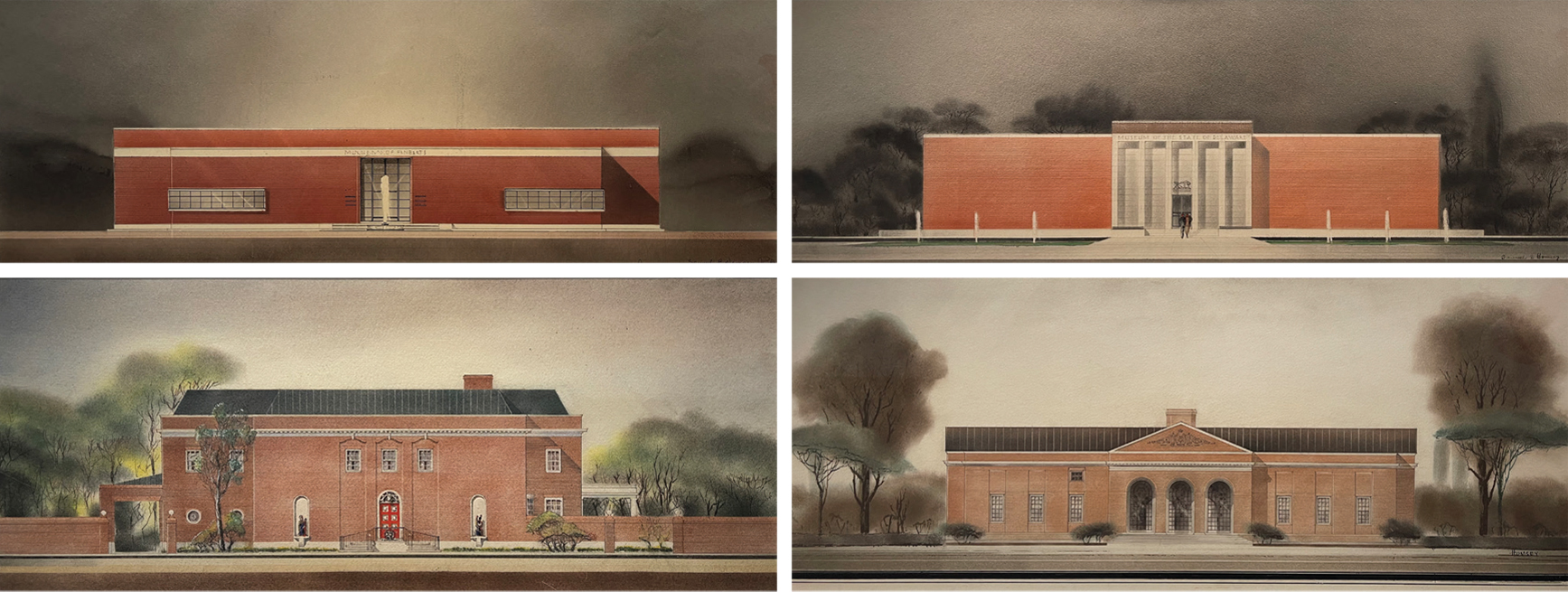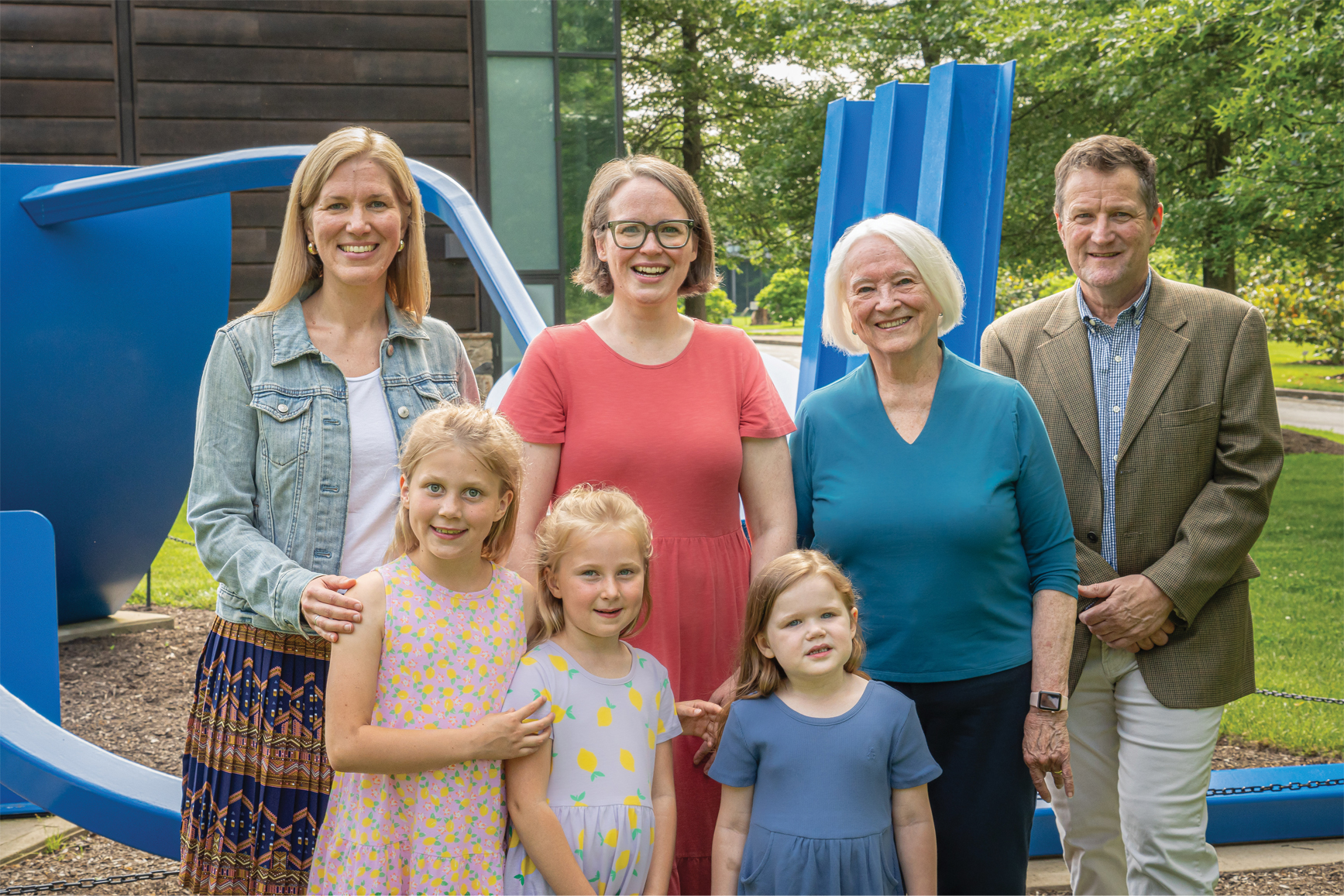Nestled in the woods between DelArt’s Sculpture Garden and the Museum’s back drive stands a private home. Built in 1905 to house the Bancroft family’s gardener and chauffeur, it later was a residence for museum curators and staff, and in 1975 became the home of Don Homsey, son of renowned architects Victorine and Samuel Homsey, who designed the Delaware Art Museum building in 1938. Today, the house remains in the Homsey family, and Sam and Vicky’s grandchildren and great-grandchildren are regular Museum visitors, members, and volunteers. We gathered with Elizabeth Homsey and her adult children Andrew Homsey, Margaretta Kroeger, and Catherine Macey-MacLeod to learn about their family history and unique perspective on DelArt.
Andrew: I moved to the house behind the Museum in 1975 with my father and mother, my dad’s first wife, Sophie Pyle Homsey. She was the great-niece of Howard Pyle. I took art lessons here, in the original classroom building that Sam and Vicky designed in the 1950s. Over time, the Museum has changed, but the heart of the main building that remains is classic; it’s one of my grandparents’ best works.
Elizabeth: I came here in 1978.
Catherine: Margaretta and I grew up in the house. We learned to ride bikes in the Museum’s parking lot, and the sculpture Electroglide was right outside our window then. Margaretta: Every Saturday morning, I walked across the field to take art classes. The Museum was woven into the fabric of our lives—we looked out on it every day, and we were very aware that our grandfather and grandmother had designed the building.
Andrew: Our grandparents first moved to Delaware when Lammot and Pamela Copeland commissioned them to design their house, Mt. Cuba.
Catherine: Mt. Cuba is similar to the Delaware Art Museum—a Georgian-style house. For the Museum, they rendered four different possible designs. Some were much more modern. Andrew: My grandparents were very talented and able to switch between styles.

Catherine: Our grandmother was so special—a working mother in the ’30s, one of the first female architects.
I have a vivid memory from my childhood of The Mermaid and Marooned, and being struck by these wonderful but scary paintings that were bigger than me. I was in awe of The Mermaid, so luminous and sparkling.
Andrew: The Pyle paintings are so great for kids. Back then the Museum didn’t really change much, but we’d come and visit the illustrations. There’s so much more here now. Catherine: It’s not as formal as it used to be, and the staff are so friendly. I love taking the girls to Story and Studio. We go into Kids’ Corner, into the galleries, and into the studios. It’s literacy, it’s art, it’s learning how to appreciate the museum, and spending time creating.
Margaretta: We notice the diversity of the artists that are featured, the perspectives, the public programming. I like the emphasis on engaging kids from all over Wilmington and Delaware. This Museum is international in scope—we loved The Rossettis—yet it also has a neighborhood feel.
Andrew: Having experienced the more traditional Delaware Art Museum of the past, I now see DelArt becoming embedded in the community, serving the whole city, and also reaching out globally. I’m impressed. That’s why we’re members.
Catherine: On the Art of the Cocktail Committee, I love being part of such a vibrant, committed group of women, working together to raise support for the Museum’s education program. The energy that people like [DelArt Board President] Christine Moritz and [Executive Director] Molly Giordano bring to this Museum is infectious.
Margaretta: DelArt provides an opportunity to connect with people we might not otherwise meet, and find this common thread in our mutual love for the Museum. Watching my girls at the age I was when I began visiting, I can look back and see how much the Museum has enriched my life. I see it enriching theirs more and more, too. I don’t feel an obligation, I feel excitement to do what I can to support this Museum and share it with others. And I appreciate that there are ways to contribute and get involved at all levels.
Elizabeth: When the girls were growing up, there wasn’t even a back entrance open to the public. But this design, spilling out to the terrace and sculpture garden, is so accessible today. Buildings affect people’s expectations and experiences, and here the spaces are so inviting.
If anyone understands the power of buildings to affect our lives, it’s the Homseys. We are grateful for the family’s impact—past and present—at DelArt.


